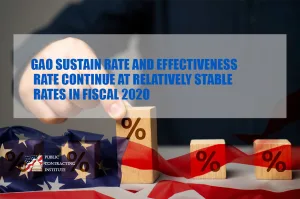By Richard D. Lieberman, Consultant The Government Accountability Office (“GAO”) released its annual bid protest report to the Congress for fiscal year 2020 on December 23, 2020 (B-158766). The GAO actually received 2,149 protests in fiscal year (“FY”) 2020 but dismissed or immediately denied or dismissed a substantial number of them, while actually considering and issuing decisions on 545 protests, known as “merit decisions.” This was a small decrease compared to FY 2019. The GAO sustain rate increased two percent, from 13 percent in FY 2019 to 15 percent in FY 2020. The other key GAO bid protest statistics for fiscal years 2016-2020 were as follows:

GAO Bid Protest Statistics for Fiscal Years 2016-2020
| FY2016 | FY2017 | FY 2018 | FY 2019 | FY 2020 | |
| Merit decisions | 616 | 581 | 622 | 587 | 545 |
| Sustained | 139 | 99 | 92 | 77 | 84 |
| Sustain rate | 23% | 17% | 15% | 13% | 15% |
| Effectiveness rate | 46% | 47% | 44% | 44% | 51% |
| Alternative Dispute Resolution (ADR) cases | 69 | 81 | 86 | 40 | 124 |
| ADR success rate | 84% | 90% | 77% | 90% | 82% |
| Hearings | 2.5% (27 cases) | 2% (17 cases) | 0.5% (5 cases) | 2% (21 cases) | 1% (9 cases) |
The “effectiveness rate” increase somewhat, from about 44 percent in 2019 to 51 percent in 2020. These are protests where the protester obtains some form of relief from the agency, either as a result of voluntary agency corrective action or the protest being sustained. The percentage of cases where the GAO conducted a hearing remained small—generally only 1 or 2 percent of the cases. GAO also reported that:
- There were no instances in which a federal agency did not fully implement a GAO recommendation in FY 2020; and
- GAO issued its decision on every protest within 100 days, as required by law.
Finally, the GAO reported on the most prevalent reasons for sustaining protests that were actually resolved on the merits in FY 2020. These were:
- Unreasonable technical evaluation
- Flawed solicitation
- Unreasonable cost or price evaluation and
- Unreasonable past performance evaluation.
The GAO also noted that a significant number of protests it received did not reach a decision on the merits because agencies voluntarily took corrective action rather than defend the protest on the merits. Agencies need not and do not report any of the many reasons they decide to take voluntary corrective actions.
Historical Posts about GAO Bid Protest Statistics
GAO Activity in Fiscal Year 2022
GAO ACTIVITY IN BID PROTESTS REMAINS STABLE IN FISCAL 2021
GAO SUSTAIN RATE AND EFFECTIVENESS RATE CONTINUE AT RELATIVELY STABLE RATES IN FISCAL 2020
GAO Sustain Rate and Effectiveness Rate Continue at Relatively Stable Rates in Fiscal 2019

